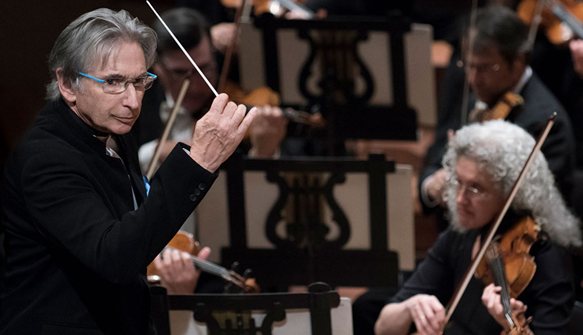
COMING OF AGE WITH THE MAHLER SYMPHONIES
We’re not the world leaders in music education, but we’ve evolved rather incredibly in concert maturity.
Between the two world wars Grandma would proudly attend the afternoon musicale concerts at a Washington, DC club and rave about the Pilgrim’s Chorus or the Strauss waltz she had heard. It was virtually the only classical music in the nation’s capital apart from the symphony with its mediocre conductor, playing in a huge hall. One of the musicians later reported that at the club, the audience didn’t enjoy any music more than eight minutes long.
As late as the mid-1950s, the news magazine Time called the capital “a cultural backwater.”
These comparisons came to mind on hearing the SFS perform Mahler’s vast Symphony No. 3, 107 minutes nonstop, seamlessly—just one of a string of Mahlers they play once or twice every year. The Third is not one of the flashiest nor catchiest, but still an opus mesmerizing the patient, silent patrons demonstrating superior Sitzfleisch (endurance, in polite terms) nowadays. And at the final note they stand and erupt and even cheer with immense enthusiasm.
It’s a monumental work for augmented ensemble, so large that the musicians are virtually piggy-back, and the set of chimes had to be shunted off to the Terrace Section on high, upstage. The woodwinds and brass were double-sized, and there’s a pair of harps and pair of portly timpani—This was all jumbo orchestra, the human mechanism for carrying off the Austrian composer’s immensely complex weave of themes. His symphony was to depict life stimuli in many facets, from nature to humans to animals, even to the sun and angels—all obliquely.
Though this ends with an underplayed Adagio, still this extravaganza makes a fitting conclusion to the SFS subscription season.
Like Beethoven and Berlioz before him, Mahler incorporated voices into the symphony, this time with texts emphasizing both joy and despair, with typical late-romantic, Mahlerian emotional extremes. If the Nietsche “Take Heed, Humanity” text sung by Sasha Cooke showed anguish, the flip side was the following youth chorus dancing about with ecstatic angels. Unlike the dark, dark contralto often heard, here Cooke provided her articulate lyric mezzo, in measured, flawless German.
The only flaw here was the delicacy of the boys chorus’ sound, to which the power of some 40 (adult) female voices of the SFS Chorus had to be added for proper balance with the orchestra.
No symphony known has more demanding trombone solos than this, executed in soft-glove and tough-love variants by Timothy Higgins.
Comparable were multiple solos by trumpeter Mark Inouye, variously both on-stage and hidden in the terraces above. MTT conducted these massive forces with sensitivity, even at times tenderness. His performance June 29 ran 107 minutes, a full seven minutes longer than the typical textbook length, and yet still did not seem stretched or lugubrious. Mahler seems to be, as much as anything, his home base of operations; Mahler left us a legacy of roughly 10 symphonies; you wished had left twice as many. Possibly he might have, had his frail heart not given out at age 50, in 1911.
Normally all the violins are on stage right. But for Mahler, MTT placed them downstage antiphonally, with cellos now further upstage.
Spotted in the lobby preconcert was SFS bassoonist Steven Dibner at his most affable, his great stalk of an instrument in hand. “I like to meet the public,” he noted. “Usually we’re very separated in the concert hall. Besides, a lot of people don’t know what a bassoon looks like.”
MAHLER SYMPHONY NO. 3, by S.F. Symphony and Chorus, plus boys choir, through June 30, at Davies Hall, S.F. Michael Tilson Thomas conducting. For info:(415) 864-6000, or go online.